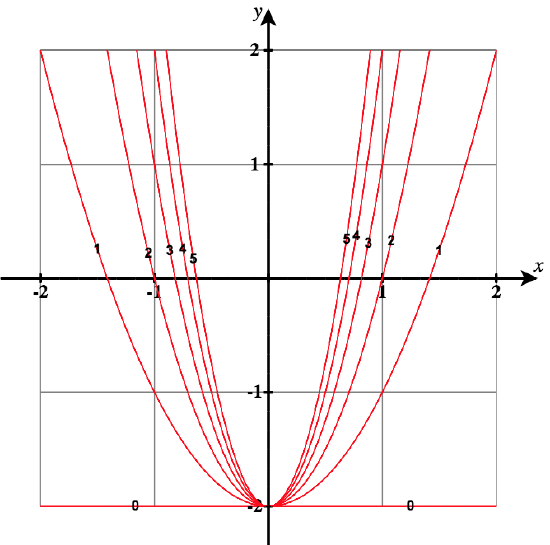13.1E: Functions of Multiple Variables (Exercises)
- Last updated
- Jan 6, 2020
- Save as PDF
- Page ID
- 30623
( \newcommand{\kernel}{\mathrm{null}\,}\)
For the following exercises, evaluate each function at the indicated values.
1) W(x,y)=4x^2+y^2. Find W(2,−1), W(−3,6).
- Answer
- W(2,−1) = 17,\quad W(−3,6) = 72
2) W(x,y)=4x^2+y^2. Find W(2+h,3+h).
3) The volume of a right circular cylinder is calculated by a function of two variables, V(x,y)=πx^2y, where x is the radius of the right circular cylinder and y represents the height of the cylinder. Evaluate V(2,5) and explain what this means.
- Answer
- V(2,5) = 20π\,\text{units}^3 This is the volume when the radius is 2 and the height is 5.
4) An oxygen tank is constructed of a right cylinder of height y and radius x with two hemispheres of radius x mounted on the top and bottom of the cylinder. Express the volume of the cylinder as a function of two variables, x and y, find V(10,2), and explain what this means.
For exercises 5 - 10, find the domain and range of the given function. State the domain in set-builder notation and the range in interval notation.
5) V(x,y)=4x^2+y^2
- Answer
- Domain: \big\{(x, y) \, | \, x \in \rm I\!R, y \in \rm I\!R\big\} That is, all points in the xy-plane
Range: [0, \infty)
6) f(x,y)=\sqrt{x^2+y^2−4}
- Answer
- Domain: \big\{(x, y) \, | \, x^2+y^2 \ge 4\big\}
Range: [0, \infty)
7) f(x,y)=4\ln(y^2−x)
- Answer
- Domain: \big\{(x, y) \, | \, x<y^2 \big\}
Range: (-\infty, \infty)
8) g(x,y)=\sqrt{16−4x^2−y^2}
- Answer
- Domain: \big\{(x, y) \, | \, \dfrac{x^2}{4} + \dfrac{y^2}{16} \le 1\big\}
Range: [0, 4]
9) z=\arccos(y−x)
- Answer
- Domain: \big\{(x, y) \, | \, x - 1 \le y \le x + 1\big\} That is, all points between the graphs of y = x -1 and y = x +1 .
Range: [0, \pi]
10) f(x,y)=\dfrac{y+2}{x^2}
- Answer
- Domain: \big\{(x, y) \, | \, x\neq 0 \big\}
Range: (-\infty, \infty)
Find the range of the functions.
11) g(x,y)=\sqrt{16−4x^2−y^2}
- Answer
- \big\{z \, | \, 0≤z≤4\big\} or in interval notation: [0,4]
12) V(x,y)=4x^2+y^2
13) z=y^2−x^2
- Answer
- The set \rm I\!R
In exercises 14 - 29, find the level curves of each function at the indicated values of c to visualize the given function. Sketch a contour plot for those exercises where you are asked for more than 3 values of c.
14) z(x,y)=y^2−x^2, \quad c=1
15) z(x,y)=y^2−x^2,\quad c=4
- Answer
- y^2−x^2=4, a hyperbola
16) g(x,y)=x^2+y^2;\quad c=0, 1, 2, 3, 4, 9
17) g(x,y)=4−x−y;\quad c=0,1, 2, 3, 4
- Answer
- Level curves are lines with y = -x + (4 - c) .
For each value of c these are:
c = 0: \, y = -x + 4,
c = 1: \, y = -x + 3,
c = 2: \, y = -x + 2,
c = 3: \, y = -x + 1,
c = 4: \, y = -x .
The contour plot consists of a series of parallel lines.
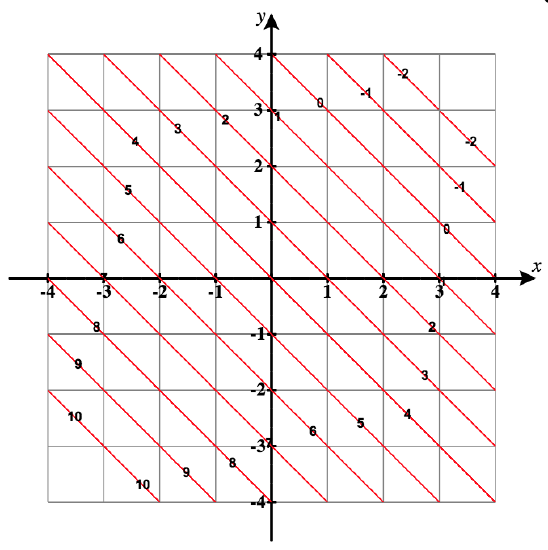
18) f(x,y)=xy;c=1;\quad c=−1
19) h(x,y)=2x−y;\quad c=-2,0,2
- Answer
- 2x−y=0,2x−y=−2,2x−y=2; three lines
20) f(x,y)=x^2−y;\quad c=1,2
21) g(x,y)=\dfrac{x}{x+y};c=−1,0,1,2
- Answer
- Level curves are lines with the form y = x \left( \dfrac{1-c}{c} \right) . At c = 0, we solve it directly from the equation \dfrac{x}{x+y}=0 to get x = 0.
For each value of c these are:
c = -1: \, y = -2x,
c = 0: \, x = 0,\text{ with }y \ne 0,
c = 1: \, y = 0,\text{ with }x \ne 0,
c = 2: \, y = -\frac{1}{2}x.
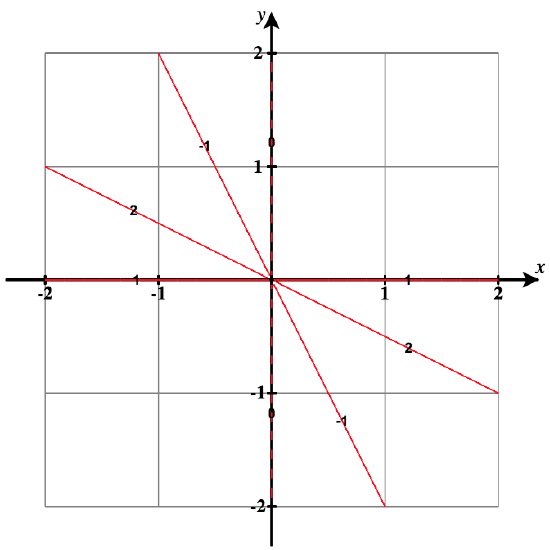
22) g(x,y)=x^3−y;\quad c=−1,0,2
23) g(x,y)=e^{xy};\quad c=\frac{1}{2},3
- Answer
- The level curves have the form, y = \dfrac{\ln c}{x}.
For each value of c these are:
c = \frac{1}{2}: \, y = \dfrac{\ln \frac{1}{2}}{x} that can be rewritten as, y = -\dfrac{\ln 2}{x}
c = 3: \, y = \dfrac{\ln 3}{x}.
24) f(x,y)=x^2;\quad c=4,9
25) f(x,y)=xy−x;\quad c=−2,0,2
- Answer
- Level curves have the form: y = \dfrac{c}{x} + 1.
Here y = \dfrac{-2}{x} + 1,\quad y = 1,\quad y = \dfrac{2}{x} + 1 or xy−x=−2,\,xy−x=0,\,xy−x=2
26) h(x,y)=\ln(x^2+y^2);\quad c=−1,0,1
27) g(x,y)=\ln\left(\dfrac{y}{x^2}\right);\quad c=−2,0,2
- Answer
- The level curves have the form, y =e^c x^2.
For each value of c these are:
c = -2: \, y = e^{-2} x^2 ,
c = 0: \, y = x^2 ,
c = 2: \, y = e^{2} x^2 .
28) z=f(x,y)=\sqrt{x^2+y^2},\quad c=3
29) f(x,y)=\dfrac{y+2}{x^2},\quad c= any constant
In exercises 30-32, find the vertical traces of the functions at the indicated values of x and y, and plot the traces.
30) z=4−x−y, \quad x=2
31) f(x,y)=3x+y^3, \quad x=1
- Answer
-
z=3+y^3, a curve in the zy-plane with rulings parallel to the x-axis
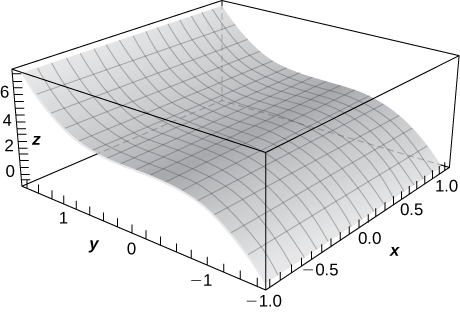
32) z=\cos\sqrt{x^2+y^2}, \quad x=1
In exercises 33 - 38, find the domain and range of each function.
33) z=\sqrt{100−4x^2−25y^2}
- Answer
- Domain: \big\{(x, y) \, | \, \dfrac{x^2}{25}+\dfrac{y^2}{4}≤1\big\}
Range: [0, 10]
34) z=\ln(x−y^2)
35) f(x,y,z)=\dfrac{1}{\sqrt{36−4x^2−9y^2−z^2}}
- Answer
- Domain: \big\{(x, y, z) \, | \, \dfrac{x^2}{9}+\dfrac{y^2}{4}+\dfrac{z^2}{36}<1\big\}
Range: \big[\frac{1}{6}, \infty\big)
36) f(x,y,z)=\sqrt{49−x^2−y^2−z^2}
37) f(x,y,z)=\sqrt[3]{16−x^2−y^2−z^2}
- Answer
- Domain: All points in xyz-space
Range: \big(-\infty, \sqrt[3]{16}\,\big]
38) f(x,y)=\cos\sqrt{x^2+y^2}
In exercises 39 - 40, plot a graph of the function.
39) z=f(x,y)=\sqrt{x^2+y^2}
- Answer
-
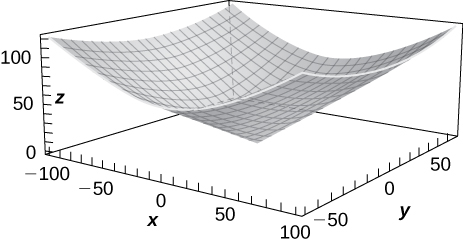
40) z=x^2+y^2
41) Use technology to graph z=x^2y.
- Answer
-
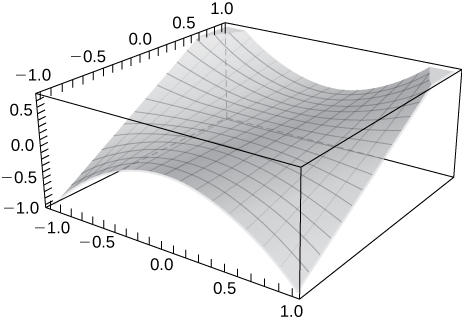
In exercises 42 - 46, sketch the function by finding its level curves. Verify the graph using technology, such as CalcPlot3D.
42) f(x,y)=\sqrt{4−x^2−y^2}
43) f(x,y)=2−\sqrt{x^2+y^2}
- Answer
-
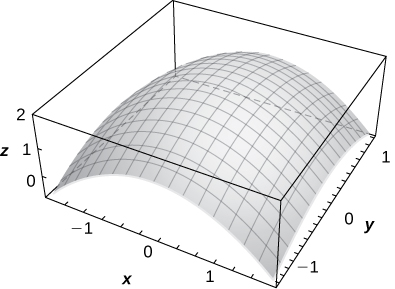
44) z=1+e^{−x^2−y^2}
45) z=\cos\sqrt{x^2+y^2}
- Answer
-
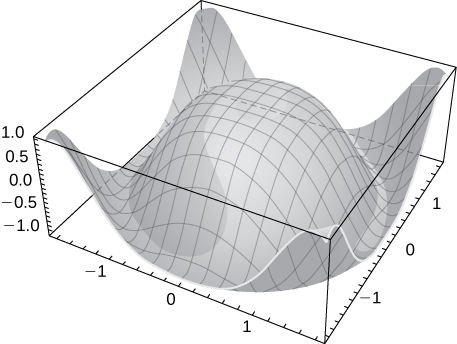
46) z=y^2−x^2
47) Describe the contour lines for several values of c for z=x^2+y^2−2x−2y.
- Answer
- The contour lines are concentric circles centered at the point, (1, 1) .
You can see this by completing the square after setting this function equal to c.
That is, we write x^2-2x+1+y^2−2y+1 = c + 2 which can be rewritten as, (x - 1)^2 + (y - 1)^2 = c + 2 .
This gives us circles centered at the point, (1, 1) , each with a radius of \sqrt{c+2} .
In exercises, 48 - 52, find the level surface for the given value of c for each function of three variables and describe it.
48) w(x,y,z)=x−2y+z,\quad c=4
49) w(x,y,z)=x^2+y^2+z^2,\quad c=9
- Answer
- x^2+y^2+z^2=9, a sphere of radius 3
50) w(x,y,z)=x^2+y^2−z^2,\quad c=−4
51) w(x,y,z)=x^2+y^2−z^2,\quad c=4
- Answer
- x^2+y^2−z^2=4, a hyperboloid of one sheet
52) w(x,y,z)=9x^2−4y^2+36z^2,\quad c=0
In exercises 53 - 55, find an equation of the level curve of f that contains the point P.
53) f(x,y)=1−4x^2−y^2,\quad P(0,1)
- Answer
- 4x^2+y^2=1,
54) g(x,y)=y^2\arctan x,\quad P(1,2)
55) g(x,y)=e^{xy}(x^2+y^2),\quad P(1,0)
- Answer
- 1=e^{xy}(x^2+y^2)
56) The strength E of an electric field at point (x,y,z) resulting from an infinitely long charged wire lying along the y-axis is given by E(x,y,z)=k/\sqrt{x^2+y^2}, where k is a positive constant. For simplicity, let k=1 and find the equations of the level surfaces for E=10 and E=100.
57) A thin plate made of iron is located in the xy-plane The temperature T in degrees Celsius at a point P(x,y) is inversely proportional to the square of its distance from the origin. Express T as a function of x and y.
- Answer
- T(x,y)=\dfrac{k}{x^2+y^2}
58) Refer to the preceding problem. Using the temperature function found there, determine the proportionality constant if the temperature at point P(1,2) is 50°C. Use this constant to determine the temperature at point Q(3,4).
59) Refer to the preceding problem. Find the level curves for T=40°C and T=100°C, and describe what the level curves represent.
- Answer
- x^2+y^2=\dfrac{k}{40}, \quad x^2+y^2=\dfrac{k}{100}. The level curves represent circles of radii \sqrt{10k}/20 and \sqrt{k}/10
Contributors
Gilbert Strang (MIT) and Edwin “Jed” Herman (Harvey Mudd) with many contributing authors. This content by OpenStax is licensed with a CC-BY-SA-NC 4.0 license. Download for free at http://cnx.org.
- Paul Seeburger (Monroe Community College) added the contour plots to answers for problems 17, 21 and 29.


